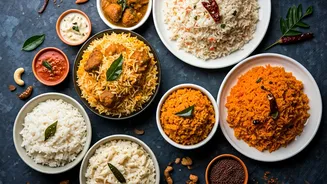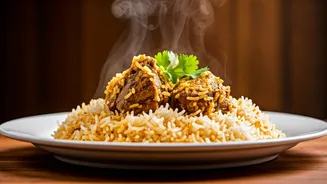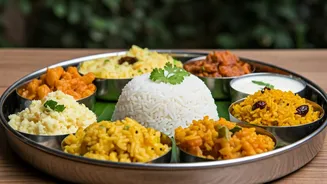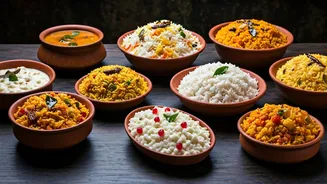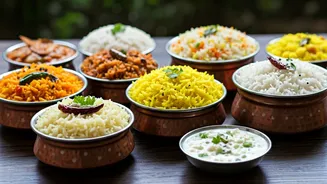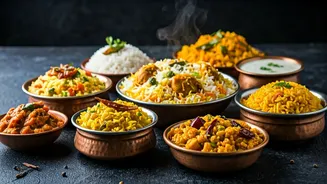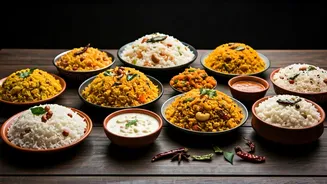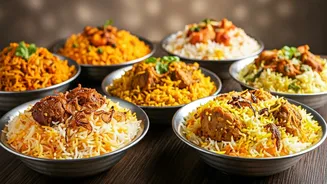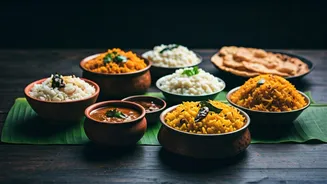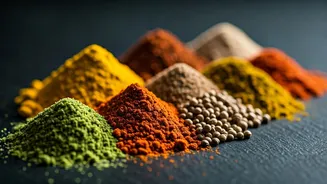Introduction to Rice
Rice forms the cornerstone of South Indian cuisine, playing a significant role in daily meals and festive celebrations. The region's climate and soil are
ideal for cultivating various rice varieties, each contributing distinct textures and tastes to the dishes. From fluffy idlis to aromatic biryanis, rice serves as a versatile base, absorbing the flavors of spices, vegetables, and meats. This culinary tradition boasts a long history, influenced by regional variations and the availability of local ingredients. The simple grain, prepared in countless ways, reflects the cultural diversity and rich heritage of South India. The diverse preparation methods demonstrate the resourcefulness and creativity of South Indian cooks. This culinary staple also symbolizes nourishment and togetherness, reflecting the region’s strong sense of community and family.
Biryani's Grandeur
Biryani, a rice dish of Persian origin, has become a cherished staple across South India, especially in Hyderabad, known for its distinct flavors. Hyderabad Biryani, or Hyderabadi Biryani, is a classic example that involves layering rice with marinated meat, aromatic spices, and sometimes vegetables, cooked using the dum pukht method. This slow-cooking process seals in the flavors, creating a dish where the tender meat and fragrant rice blend perfectly. In contrast, other regions like Tamil Nadu offer their own biryani styles, often incorporating local spices and ingredients. For instance, the Chettinad region features biryanis spiced with black pepper and a variety of freshly ground masalas. Similarly, Malabar biryani in Kerala has its unique twist with the addition of seafood or vegetables.
Lemon Rice Delight
Lemon rice, a quick and refreshing dish, is a common meal in South Indian households, particularly in Tamil Nadu. The process starts with cooked rice seasoned with the zest and juice of lemons. This gives the dish its tangy flavor. The rice is then tempered with mustard seeds, urad dal, chana dal, curry leaves, and green chilies, which adds another layer of flavor and texture. Sometimes, peanuts or cashews are added to provide a satisfying crunch. The simplicity of lemon rice makes it a versatile choice. It can be paired with chutneys, curries, or simply enjoyed on its own. It's often prepared as part of a packed lunch for its convenience and ability to remain fresh. Its quick preparation and zesty flavor make it a popular comfort food.
Tamarind Rice
Tamarind rice, another beloved staple in South Indian kitchens, offers a savory and tangy experience. Cooked rice is mixed with a tamarind-based paste, enriched with spices such as red chilies, mustard seeds, and asafoetida. The tamarind pulp provides a sour flavor. The preparation includes tempering with oil, curry leaves, and a variety of lentils to enhance the taste. The dish is known for its long shelf life, making it a good choice for travel or as a preserved meal. Tamarind rice can be customized with variations in the spice level, depending on personal preferences. The dish is also associated with religious ceremonies and auspicious occasions in South Indian culture. The robust flavor profile, balancing sourness and spice, provides a satisfying meal.
Curd Rice Comfort
Curd rice, a dish revered for its cooling effect, offers a soothing finish to a traditional South Indian meal. Cooked rice is mixed with curd (yogurt) and seasoned with salt. The dish is then tempered with mustard seeds, curry leaves, and sometimes green chilies. The creamy texture of the curd blended with the soft rice provides a gentle meal that helps aid digestion, especially during hot weather. It's often eaten as a cooling agent, and offers a pleasant contrast with spicy curries or pickles. Curd rice is very easy to prepare, so it's a good choice for quick meals. This simplicity combined with its health benefits makes curd rice a beloved staple in many South Indian homes.
Coconut Rice Treat
Coconut rice, known for its rich flavor and delicate texture, is a popular choice for celebrations and everyday meals. The dish is made by cooking rice with coconut milk, which provides a creamy base and a subtle sweetness. The rice is typically tempered with mustard seeds, urad dal, and curry leaves, and sometimes with spices like cardamom or cloves, enhancing the aroma and flavor. Shredded coconut is often added at the end for added texture and taste. This dish complements a variety of side dishes, from sambar to vegetable curries. Coconut rice is a versatile dish, perfect for festive occasions or when a touch of indulgence is desired. The gentle sweetness of coconut perfectly balances the savory spices.
Vegetable Pulao Feast
Vegetable pulao is a flavorful one-pot rice dish, incorporating a medley of fresh vegetables and aromatic spices. The cooking process includes sautéing vegetables, such as carrots, beans, peas, and potatoes, along with onions, ginger, and garlic, in ghee or oil. The rice is then added to the vegetables, along with spices, and cooked with water or vegetable stock. The dish is often seasoned with whole spices like bay leaves, cardamom, and cinnamon, enhancing its fragrance. Vegetable pulao can be customized to incorporate seasonal vegetables. The dish is often served with raita or yogurt, which adds a refreshing counterpoint to the richness of the pulao. The vibrant flavors make it a satisfying and complete meal.
Pongal Variations
Pongal, a traditional South Indian dish, is prepared with rice, lentils, and spices, usually cooked until it becomes a porridge-like consistency. Pongal is also associated with a harvest festival named after the dish, called Pongal. The dish is associated with prosperity. There are two main variations: sweet and savory. The sweet Pongal, known as 'sakkarai pongal', is made with jaggery, while savory Pongal, called 'ven pongal', is seasoned with black pepper, cumin, and ginger. Pongal is often prepared in clay pots, considered auspicious. It reflects the community's culture, symbolizing gratitude for the harvest and the well-being of the family. Whether sweet or savory, Pongal is a cherished dish, enjoyed during festive occasions and as a comforting meal.
